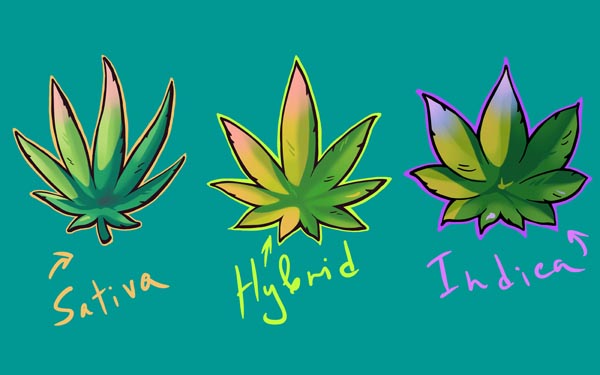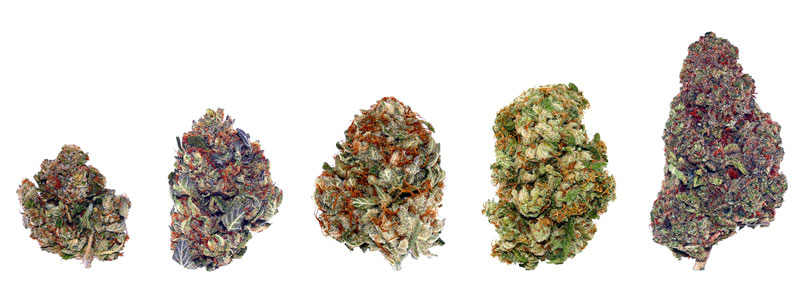What is a Strain?
A strain is a specific subspecies, or breed, of the Cannabis Sativa plant. Just like how the dog has countless breeds and hybrid cross breeds, so does the cannabis plant.
Like dogs, genetics cause each cannabis plant to have subtle or distinct differences in characteristics depending on the lineage of its parent strains.
Some of these special genetic characteristics include unique medicinal benefits.
How are Strains Categorized?

Typically, you will see strains broken down into 5 main categories. These 5 categories will usually indicate the general effects of each strain due to their unique genetic profiles.
Once again think about dogs! Since there are so many breeds, they are grouped into 7 main categories by the AKC (i.e. Terriers, Toy, Non-sporting, etc.). These categories are based on the “work” that these breeds traditionally do. Knowing what category a dog belongs to helps people more easily identify the dog and the work they are best suited for.
This is exactly like cannabis strains.
Today there are 5 main groups or categories of cannabis strains and below is a brief description of each.
Indica
- Typically provides a “body high” and works well for nighttime use, as well as when you need to relax and rest
- Grows short and bushy, with a condensed root system, broad leaves, and dense compact flowers
- Usually has relatively higher CBD to THC ratios
- Often used to help relieve insomnia, pain and stress
- An example of a popular Indica is Bubba Kush
Sativa
- Typically provides feelings of well-being and energizing cerebral effects
- Suited for daytime use, when you need to be focused and alert
- The shape of the plant and the leaves are tall and thin, while the colour is usually a light green
- Sativas usually have a higher ratio of THC to CBD when compared to Indicas
- Reported by patients to help treat mental ailments such as depression, ADHD, anxiety and fatigue
- An example of a popular Sativa is Durban Poison
Hybrid - 50/50
- Typically is a “balanced” strain with 50% of its genetics being Indica and 50% being Sativa.
- Although it is difficult to determine exactly that a strain is a 50/50 split, breeders and medical patients alike can attest that these strains are equal when it comes to their Sativa and Indica genetics, characteristics and effects.
- An example of a popular 50/50 Hybrid is Jack Herer
Hybrid - Indica Dominant
- This is similar to the 50/50 Hybrid in the sense that it is a mix of Sativa and Indica lineage although its genetics are more Indica dominant.
- For example a 75% Indica dominant hybrid is going to be mostly Indica in nature, although the Sativa genetics may help you from being overly sedated or "couch locked."
- An example of a popular Indica Dominant Hybrid is Blueberry
Hybrid - Sativa Dominant
- This is similar to the 50/50 Hybrid in the sense that it is a mix of Sativa and Indica lineage, but its genetics are more Sativa dominant
- For example a 75% Sativa Dominant strain is going to be mostly Sativa in nature, although the 25% Indica may help you stay calm and relaxed
- An example of a popular Sativa Dominant Hybrid is AK-47
As you can see, each of these strain categories is distinctly different.
Once we can identify what category a strain fits in, we are then able to have a more informed idea of what the strain’s characteristics and effects will be.
To learn more about cannabis and its varieties, we invite you to read our “What is Cannabis?” article.
What are some Examples of Different Strains and their Effects?
Hindu Kush is a 100% landrace Indica strain that produces classic Indica effects, appearances, tastes and smells. This strain, like most full Indicas, typically produces euphoric, relaxed and sedative effects that can benefit patients dealing with pain, nuesa, insomnia and stress.
To learn more about the Hindu Kush strain, we invite you to follow this link.
On the other end of the spectrum, a 100% Sativa landrace strain like Durban Poison produces classic Sativa effects, well also serving as a physical example of a “perfect” Sativa specimen; tall and thin, with long thin leaves. This is a Sativa strain that will have the opposite effects of Hindu Kush, as it energizes and excites the user, producing focused energy. This strain and others like it, have been shown to help patients who suffer from fatigue, depression, ADHD and other mood disorders.
To learn more about the Durban Poison strain, we invite you to follow this link.
As you can see, there is a significant difference between the Indica and Sativa categories. The other three categories (50/50 Hybrid, Indica Dominant Hybrid, Sativa Dominant Hybrid) all fall somewhere in between the Indica and Sativa categories depending on their specific plant genetics.
In essence, the effects you are looking for can most likely be found within these 5 groups of cannabis strains.
What is a Landrace Strain?

A landrace race strain is a strain that has been developed by father time and mother nature.
Specific geographical areas of the world have different landrace strains.
For example, Durban Poison is an ancient landrace strain that was naturally created by nature in the geographical area that is now Durban, South Africa. Another example of an African landrace strain is Malawi Gold. This strain supposedly only grows to perfection in certain areas of Malawi and when it is taken from that climate and soil, even if it is cultivated in a simulated indoor environment, it will not grow properly or produce the same “psychedelic effects” that Malawi Gold is known for.
To learn more about the Malawi Gold strain, we invite you to follow this link.
How do I Find the Strains that are Best Suited for Me?

Depending on the genetics and environmental growth conditions of a cannabis plant, different ratios of cannabinoids and terpenes are produced, and infinite variations are possible through selective breeding and blending of different chemotypes (Lewis et al., 2017).
Although the current scientific research surrounding the benefits of specific strains is still ongoing and unclear, what we do know is that you need to find the particular strains that work best for you and your ailments.
Every patient is different and what works for one patient may not work for another.
This is due in part to the function of the endocannabinoid system, and how it can vary from individual to individual.
Finding the “right” strains is important and is not necessarily an easy task.
This process is going to take time and primary and secondary research is going to be vital to your success. To help you find the “right” strains for your individual needs, we here at Kanteeva have created our Strain Directory, The Kanteeva Community and the Ailments section.
These areas of the site are designed to help you identify what strains you may benefit from the most.
To learn more about strains and how they work, we invite you to read The Kanteeva Strain Guide. We also invite you to read our Strain Management Article which may help you design a more effective medical cannabis program.
Let us know what strains are working for you by commenting below and be sure to join our Kanteeva community for more information and support.
Are you new to medical cannabis? Follow this link to learn more.
Learn. Share. Connect.
